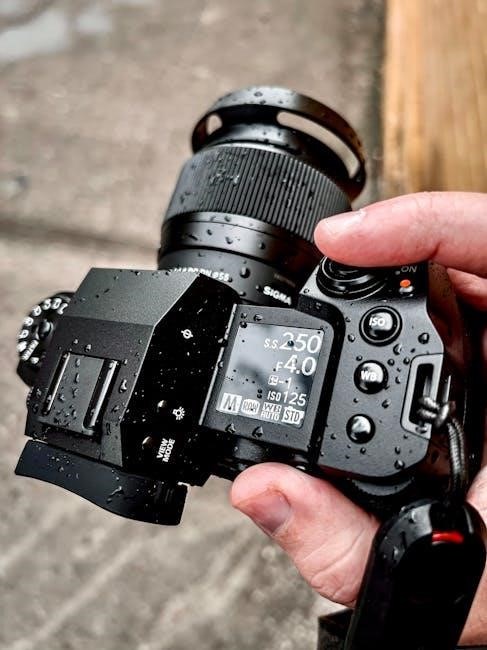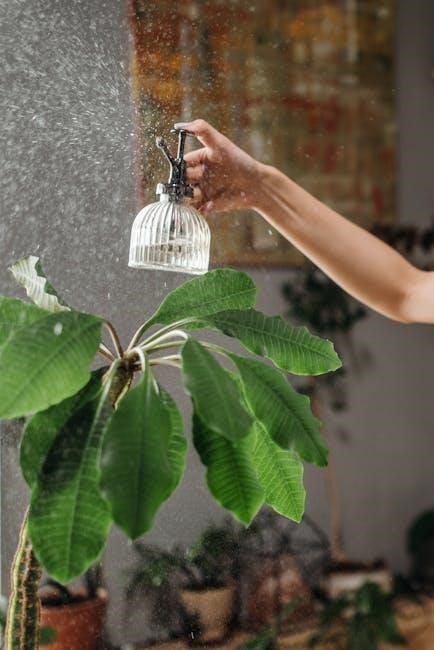A moisture meter is essential for measuring moisture content in materials like wood and concrete. This manual guides users on safe operation, calibration, and troubleshooting for accurate readings.
1.1 Importance of Moisture Meters in Various Industries
Moisture meters play a vital role in industries such as woodworking, construction, and water damage restoration. They help detect and measure moisture levels in materials like wood, concrete, and drywall, ensuring safety and preventing structural damage. In woodworking, they ensure wood is properly dried for crafting. In construction, they verify building materials are dry before installation. For water damage restoration, they locate hidden moisture to prevent mold growth. Their accuracy is crucial for maintaining quality standards and preventing costly repairs across these sectors.
1.2 Brief Overview of the General Moisture Meter Manual
This manual provides comprehensive guidance for using General moisture meters effectively. It covers key features, calibration methods, and operational steps, ensuring accurate moisture measurement in various materials. The guide emphasizes safety precautions and maintenance tips to prolong the meter’s lifespan. By understanding the manual, users can harness the full potential of their moisture meter, whether for woodworking, construction, or restoration projects, ensuring reliable results and optimal performance across different applications.

Understanding Your Moisture Meter
Understanding your moisture meter is crucial for accurate readings. Familiarize yourself with its features, types, and technologies to ensure precise moisture measurement across various materials and applications.

2.1 Key Features of the General Tools Moisture Meter
The General Tools Moisture Meter offers advanced features for precise moisture detection. It includes pinless and pin-type options, a tricolor bar graph for quick assessments, and deep sensing for thick materials. The meter also features remote probe functionality, an LCD display, and automatic shutdown to conserve battery life. Designed for versatility, it measures moisture in wood, concrete, and drywall, providing accurate readings in WME (Wood Moisture Equivalent) or percentage format. Its ergonomic design ensures ease of use, making it ideal for professionals and DIYers alike in woodworking, construction, and water damage restoration.
2.2 Types of Moisture Meters (Pin-Type vs. Pinless)
General Tools Moisture Meters come in two primary types: pin-type and pinless. Pin-type meters use two metal pins to penetrate the material surface, providing precise readings for wood and other materials. Pinless meters, however, use a non-invasive sensor to measure moisture without damaging the surface, ideal for delicate or finished materials like drywall. Both types offer accuracy but cater to different applications, making them versatile tools for woodworking, construction, and water damage restoration. Understanding the differences helps users choose the right meter for their specific needs.
2.3 Sensing Technologies Used in Moisture Meters
Moisture meters utilize advanced sensing technologies to measure moisture content accurately. Pin-type meters employ electrical resistance, where moisture levels alter the resistance between the pins. Pinless meters use capacitance or electromagnetic fields to detect moisture without surface contact. Some models incorporate infrared technology for non-invasive readings. These technologies ensure reliable measurements across various materials, from wood to concrete, making them indispensable tools in industries like construction and woodworking. Understanding the sensing technology helps users select the most suitable meter for their application.
2.4 Display Types and Interpretation (LCD, LED Bar Graph)
Moisture meters feature LCD screens or LED bar graphs for clear data interpretation. LCD displays show precise numerical readings, while LED bar graphs provide visual indicators of moisture levels using color-coded lights. Some models combine both, offering a tricolor bar graph for quick assessments. Green indicates safe moisture levels, yellow signals caution, and red alerts to high moisture. Understanding these displays ensures accurate interpretation of readings, enabling users to make informed decisions. The LCD also shows units like WME or %MC, while the LED graph offers a rapid, intuitive overview of moisture conditions.

Preparing to Use Your Moisture Meter
Before using your moisture meter, read the manual thoroughly, calibrate the device, install batteries, and understand measurement units like WME or %MC for accurate readings.
3.1 Reading the User Manual
Reading the user manual is crucial for understanding your moisture meter’s features, operation, and maintenance. It provides detailed instructions on safety precautions, measurement modes, and calibration procedures. Familiarize yourself with the meter’s components, such as sensors, displays, and controls. The manual also explains how to interpret readings, including moisture levels and error indicators. Understanding the manual ensures accurate measurements and prolongs the device’s lifespan. Take time to review troubleshooting tips and warranty information for a seamless experience. Proper preparation is key to using your moisture meter effectively and safely.
3.2 Calibration and Adjustment
Calibration ensures your moisture meter provides accurate readings. Follow the manual’s instructions to adjust the device according to the material being tested. Use reference materials of known moisture content to verify calibration. Some meters allow sensitivity adjustments for specific materials. Regular recalibration maintains accuracy over time. Proper adjustment prevents errors and ensures reliable results. Always refer to the manual for precise calibration steps tailored to your meter model. This step is essential for consistent and trustworthy measurements in various applications, from woodworking to construction.
3.3 Battery Installation and Power Management
Proper battery installation ensures optimal performance. Open the battery compartment, typically located on the back, and insert the included 9V battery. Replace the cover securely to avoid moisture exposure. The meter features automatic shutdown after two minutes of inactivity to conserve power. To extend battery life, avoid prolonged exposure to high humidity and extreme temperatures. Replace batteries when the display indicates low power or readings become inconsistent. Always use high-quality alkaline batteries for reliable operation. Refer to the manual for specific battery compartment locations and replacement procedures.
3.4 Understanding Measurement Units (WME, %MC)
Moisture meters measure moisture content in materials using two primary units: Wood Moisture Equivalent (WME) and percentage of moisture content (%MC). WME is ideal for wood and building materials, reflecting surface moisture due to the meter’s sensing technology. %MC provides precise moisture levels, essential for materials like concrete or drywall. Understanding these units is crucial for accurate readings. The meter compensates for material density and ambient humidity, but users may need to adjust settings for specific materials. Always refer to the manual for unit interpretations and calibration guidance to ensure reliable results in various applications.

Operating the Moisture Meter
This section explains how to turn on, select modes, take accurate measurements, and interpret results for various materials like wood and concrete efficiently and safely.
4.1 Step-by-Step Guide to Taking Measurements
Turn on the meter and ensure it’s set to the correct mode (e.g., wood or building materials). 2. For pin-type meters, insert probes into the material; for pinless, place the sensor flat on the surface. 3. Hold the meter steady and wait for the reading to stabilize. 4. Note the moisture level displayed in WME or %MC. 5. Take multiple readings across the material for accuracy. 6. Refer to the manual for interpreting safe, elevated, or dangerous moisture levels. Always follow safety guidelines to avoid electric shock or damage.
4.2 Using the Meter in Different Modes (Wood, Building Materials)
Select the appropriate mode for your material using the mode button or menu. For wood, choose “Wood Mode” for accurate WME readings. For other materials like concrete or drywall, switch to “Building Materials Mode.” Calibration may be needed for specific materials. Take readings by holding the meter steady on the surface or inserting probes, depending on the type. Multiple readings ensure accuracy. Compare results to baseline values for safe moisture levels. Always refer to the manual for material-specific settings to ensure reliable measurements.
4.3 Measuring Moisture on Different Surfaces (Wood, Concrete, Drywall)
For wood, use the pin or pinless mode, ensuring contact with the surface. Concrete measurements are best taken with pinless meters for non-invasive surface checks. Drywall requires a gentle touch to avoid damage. Always hold the meter flat and steady for accurate readings. Wood density may affect results, so adjust settings as needed. For concrete and drywall, ensure the surface is clean and dry for reliable data. Take multiple readings across the material to verify consistency. Refer to the manual for specific settings tailored to each surface type to ensure precise moisture detection and avoid false readings.
4.4 Interpreting Moisture Levels (Safe, Elevated, Dangerous)
Moisture levels are categorized as safe, elevated, or dangerous. For wood, safe levels are typically below 12%, elevated between 12-16%, and dangerous above 16%. For building materials, safe is below 17%, elevated up to 20%, and dangerous above 20%. The meter may use visual indicators like red LEDs or alarms for dangerous levels. If readings exceed safe thresholds, further inspection or professional intervention is recommended to prevent structural damage or mold growth. Always refer to material-specific guidelines for precise interpretations and actions.

Advanced Features and Settings
Advanced features include sensitivity adjustments, tricolor bar graphs for quick assessments, deep sensing modes for thick materials, and remote probe functionality for enhanced convenience and accuracy.
5.1 Adjusting Sensitivity for Various Materials
Adjusting sensitivity ensures accurate readings across different materials. For wood, sensitivity is often preset, while for concrete or drywall, it may need fine-tuning. Refer to the manual for specific calibration steps based on material type. Adjustments can typically be made via the meter’s menu, ensuring optimal performance and precise moisture detection. Proper sensitivity settings prevent false readings and enhance reliability in various applications, from woodworking to construction.
5.2 Using the Tricolor Bar Graph for Quick Assessments
The Tricolor Bar Graph provides a quick visual assessment of moisture levels. Green indicates safe moisture levels, yellow signals caution, and red warns of dangerous moisture content. This feature allows users to make rapid decisions without interpreting detailed numerical data. The bar graph updates in real-time, offering an intuitive way to monitor moisture conditions. Refer to the manual for specific color coding interpretations, as they may vary slightly depending on the material being tested. This tool is particularly useful in time-sensitive applications like water damage restoration or construction site inspections.
5.3 Enabling Deep Sensing for Thick Materials
For materials like dense wood or thick concrete, enable Deep Sensing mode to measure moisture beyond the surface. Access this feature via the menu settings, typically marked by a depth icon or labeled as “Deep Mode.” Once activated, the meter emits a stronger electromagnetic field, allowing penetration up to several inches. A confirmation LED or tone will indicate successful activation. This mode is ideal for assessing moisture in heavy construction materials or large wood beams, ensuring accurate readings even in challenging conditions. Always calibrate the meter for the specific material before use for optimal accuracy;
5.4 Remote Probe Functionality (If Applicable)
For enhanced flexibility, certain moisture meters offer remote probe functionality. This feature allows users to measure moisture in hard-to-reach areas without moving the main unit.Connect the remote probe via the designated port on the meter. Ensure the probe is securely attached and powered on. The meter will display readings from the probe in real-time. This feature is particularly useful for assessing moisture in large or inaccessible materials, such as thick wood beams or high ceilings. Refer to the manual for specific instructions on pairing and operating the remote probe effectively.

Maintenance and Care
Regular cleaning of sensors and storing in a dry place ensures accuracy. Replace batteries as needed and avoid extreme temperatures to prolong meter longevity and performance.
6.1 Cleaning the Meter and Sensors
Regularly clean the meter and sensors to ensure accuracy. Use a soft, dry cloth to wipe the exterior and sensors. Avoid harsh chemicals or abrasive materials that could damage surfaces. For metal sensors, gently remove dirt or residue with a slightly damp cloth, then dry thoroughly. Proper cleaning prevents corrosion and ensures reliable readings. Store the meter in a dry, cool place when not in use to maintain its performance and longevity over time.
6.2 Storing the Meter Properly
Store the moisture meter in a dry, cool place away from direct sunlight and extreme temperatures. Use a protective case to prevent damage and ensure the meter remains clean. Avoid exposing it to moisture or humidity, as this can affect its accuracy. Keep it away from metal objects to prevent static interference. Proper storage ensures the meter maintains its performance and longevity, providing reliable readings when needed. Always refer to the manual for specific storage instructions tailored to your device.
6.3 Replacing Batteries and Extending Battery Life
To replace the battery, open the compartment, remove the old one, and insert a new 9V battery, ensuring proper orientation. Turn off the meter when not in use to conserve power. Clean battery contacts regularly to maintain connectivity. Store spare batteries in a cool, dry place. Avoid extreme temperatures, as they can drain battery life. Replace batteries promptly if the meter shows low power indicators. Proper care ensures reliable performance and extends the meter’s operational life. Always use high-quality batteries for optimal results.
6.4 Regular Firmware Updates (If Applicable)
Regular firmware updates ensure your moisture meter performs optimally. Check the manufacturer’s website for the latest software version. Download and install updates using a compatible cable. Follow on-screen instructions carefully to avoid interruptions. Updated firmware enhances accuracy, adds features, and fixes bugs. Always use the correct cable to prevent damage. After updating, restart the meter to apply changes. Keep your device up-to-date for reliable measurements and improved functionality. Consult the manual for specific update procedures if applicable to your model.

Troubleshooting Common Issues
Resolve inaccurate readings by calibrating or cleaning sensors. Address battery issues by replacing or charging. For sensor malfunctions, consult the manual or contact support for repairs.
7.1 Resolving Inaccurate Readings
Inaccurate readings can often be resolved by checking the battery life or cleaning the sensor. Ensure the meter is calibrated for the material being tested. Verify that the correct mode (wood, building materials) is selected. For pin-type meters, ensure probes are fully inserted. For pinless meters, check for surface interference. If issues persist, refer to the manual for recalibration steps or contact customer support. Regular maintenance and proper handling can prevent recurring inaccuracies and extend the meter’s reliability. Always follow the manufacturer’s guidelines for troubleshooting.
7.2 Fixing Battery Life Issues
Battery life issues can be addressed by replacing the battery with a fresh one. Ensure the correct 9V battery is used as specified in the manual. Turn off the meter when not in use to conserve power. Avoid extreme temperatures, as they can drain the battery faster. If the meter has an auto-shutoff feature, ensure it is enabled to prevent unnecessary battery drain. Clean the battery contacts to maintain proper connectivity. Refer to the manual for specific instructions on replacing and managing the battery for optimal performance and longevity.
7.3 Addressing Sensor Malfunctions
Sensor malfunctions can often be resolved by cleaning the probes or pins with a soft cloth. Ensure no debris or moisture obstructs the sensors. For pinless meters, check the sensing area for dirt or damage. If issues persist, recalibrate the meter according to the manual. Avoid exposing sensors to extreme temperatures or chemicals. If the meter has been dropped, inspect for physical damage and test on a known material. Replace sensors if damaged beyond repair. Regular maintenance and proper storage can prevent future malfunctions. Always refer to the manual for specific troubleshooting steps for your model.
7.4 Solving Connectivity Problems (If Applicable)
For meters with remote probes, ensure the probe is securely connected to the main unit. Check for loose or damaged cables and ports. Verify battery power to both the meter and probe. If using wireless connectivity, confirm the device is properly paired. Restart the meter and probe, then re-establish the connection. Avoid interference from nearby electronic devices. If issues persist, update the firmware to the latest version. Clean the connectors with a soft cloth and ensure no debris obstructs the connection. Consult the manual for specific pairing instructions or contact customer support for assistance.

Safety Precautions
Handle probes carefully to avoid damage or injury. Avoid using the meter near water or in hazardous environments to prevent electric shock or equipment damage.
8.1 Avoiding Electric Shock
To prevent electric shock, avoid using the moisture meter near water or in wet environments. Never submerge the device or expose it to excessive moisture. Ensure all probes and sensors are undamaged and properly insulated. Avoid touching electrical components or probes with bare hands. Use the meter only in well-ventilated areas, away from conductive materials. Always follow the manufacturer’s guidelines for battery replacement and avoid mixing old and new batteries. Regularly inspect the device for signs of damage or wear, and discontinue use if any issues are detected. Proper handling ensures safe and reliable operation.
8.2 Preventing Damage to the Meter
To prevent damage to your moisture meter, store it in a dry, cool place away from direct sunlight. Avoid dropping or exposing it to physical stress. Clean the sensors regularly with a soft cloth to ensure accurate readings. Use a protective case when transporting the device. Replace batteries correctly, ensuring polarity is maintained, and avoid using damaged or leaking batteries. Do not operate the meter in extreme temperatures or humidity levels. Regular maintenance and proper handling will extend the lifespan and performance of your moisture meter.
8.3 Working in Hazardous Environments
When using your moisture meter in hazardous environments, ensure the device is rated for such conditions. Use explosion-proof equipment if working near flammable materials. Avoid exposing the meter to extreme temperatures, chemicals, or high humidity, as this may damage internal components. Always wear appropriate personal protective equipment (PPE) and follow safety protocols. Check the user manual for environmental limitations and ensure the meter is calibrated for the specific conditions. Never operate the device near open flames or sparks, and keep it away from direct contact with hazardous substances to prevent accidents and ensure accurate readings.
8.4 Proper Handling of Probes and Sensors
Always handle probes and sensors with care to maintain accuracy and longevity. Clean them regularly with a soft, dry cloth to remove dirt or debris. Avoid exposing probes to excessive force, bending, or prolonged contact with corrosive materials. Store probes in a protective case when not in use to prevent damage. For pinless sensors, ensure the surface is flat and free of obstructions for accurate readings. Never submerge sensors in water or subject them to extreme temperatures, as this may damage the internal components and affect performance.

Warranty and Support
This section covers warranty details, repair or replacement options, and customer support contact information to ensure your moisture meter is protected and functional for long-term use.
9.1 Understanding the Warranty Coverage
The warranty ensures your moisture meter is protected against defects in material and workmanship. Coverage typically lasts for one year from the date of purchase. It includes repairs or replacements if the device fails under normal use. However, damages from misuse, tampering, or wear and tear are excluded. Registration and proof of purchase are often required to validate the warranty. This coverage provides assurance of quality and support, ensuring your tool remains reliable for its intended purpose.
9.2 Contacting Customer Support
For assistance with your moisture meter, contact General Tools & Instruments via phone at (212) 431-6100 or toll-free at (800) 697-8665. Fax inquiries can be sent to (212) 431-6499. Email support is available at sales@generaltools.com. Visit their website at www.generaltools.com for additional resources or to submit a query online. Their office is located at 80 White Street, New York, NY 10013. Customer support is available to address warranty claims, troubleshooting, and product-related questions, ensuring prompt resolution for any issues.
9.3 Repair and Replacement Options
General Tools offers repair or replacement options for defective moisture meters under warranty. If your meter malfunctions due to material or workmanship issues, contact customer support to initiate the process. Repairs are performed by authorized personnel only; unauthorized repairs void the warranty. For non-warranty cases, contact support for repair cost estimates or replacement options. Regular maintenance, like cleaning sensors and replacing batteries, can prevent issues. Visit their website for detailed repair policies and to submit a service request form, ensuring your meter operates accurately for years to come.
9.4 Registering Your Product
Registering your moisture meter ensures warranty validation and access to exclusive support. Visit General Tools’ official website and complete the registration form with your product’s serial number, purchase date, and contact details. This process helps track your device for potential updates, recalls, or promotional offers. Ensure to retain your purchase receipt and registration confirmation for future reference. Registration is quick and enhances your product experience, providing priority assistance and notifications about new features or firmware updates.
Proper use and maintenance of your moisture meter ensure accurate measurements. Regularly clean sensors, store the meter correctly, and follow safety guidelines to avoid damage and electric shock.
10.1 Summary of Key Points
The General Moisture Meter Manual emphasizes proper usage, calibration, and maintenance for accurate readings. Key features include pin and pinless options, tricolor bar graphs, and adjustable sensitivity for various materials. Regular battery checks, sensor cleaning, and firmware updates ensure optimal performance. Safety precautions like avoiding electric shock and handling probes carefully are crucial. Troubleshooting tips address common issues like inaccurate readings and connectivity problems. Following the manual ensures long-term reliability and safe operation, making it an essential tool for woodworking, construction, and water damage restoration.
10.2 Best Practices for Long-Term Use
For long-term use, store the moisture meter in a dry environment and avoid extreme temperatures. Regularly clean the sensors and probes to ensure accuracy. Replace batteries promptly when low, and update firmware as needed. Use the correct mode for the material being tested to prevent damage. Calibrate the device periodically and refer to the manual for specific adjustments. Proper handling and storage will extend the meter’s lifespan and maintain its reliability for consistent, accurate readings across various applications.
